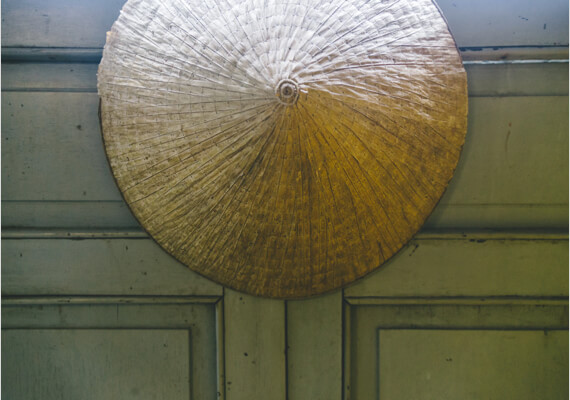WELCOME TO NON LA
HANDMADE STORE
UNIQUELY DESIGNED AND MADE FROM HI CLASS MASTERS
05 KEY THINGS "NON LA" WORTH YOUR ATTENTION

Non la has its own origin
Like many other traditional costumes of Vietnam, Non la has its own origin, coming from a legend related to the history of rice growing in Vietnam. The story is about a giant woman from the sky who has protected humankind from a deluge of rain. She wore a hat made of four round shaped leaves to guard against all the rain. After the Goddess was gone, Vietnamese built a temple to commemorate her as the Rain-shielding Goddess.
You may sometimes wonder where the moon came from. Was it a planet that traveled too close to Earth and was captured in our orbit? Actually, the prevailing theory of modern science is that the moon was the result of a large scale collision with the still developing Earth early in its development which caused this large “chuck” to spin off into an orbiting body. This explains the similarity in composition as has been confirmed by many of the moon exploratory space missions that were conducted by NASA.
Non la is made of such simple materials
Non la is made out of such simple and available materials as palm leaves, bark of Moc tree and bamboo. Non la is abundantly sold and there are many traditional villages where tourists can get high quality conical hats.
There is something about parenthood that gives us a sense of history and a deeply rooted desire to send on into the next generation the great things we have discovered about life. And part of that is the desire to instill in our children the love of science, of learning and particularly the love of nature.


The image of Non la
Vietnamese tried to make a hat modelling after the Goddess' by stitching together palm leaves, which is now known as Non la. The image of Non la has become strongly associated with peasant lives from the paddy field to boat men and women.
Your fascination with the universe and how to explore it as we so often do in the field of astronomy can be highly academic and dry as maybe it was if you took a course in astronomy. But when you get out there in the field at night, your equipment is just right and the night sky comes alive with activity, there is no other experience like it for majesty and pure excitement. And that is the kind of experience we want our children to come to love as much as we do.
Non la has numerous uses
Non la can serve numerous uses such as a personal sun proof, a basket for women going to market, a fan of a ploughman in hot summer days, or even a keepsake to memorize. The image of a young lady wearing Non la and Ao dai is a beautiful symbol of Vietnam.
It’s actually not a big jump from play to learning for children when it comes to learning about the natural world, science and astronomy. Exploration is a natural part of being a child and growing up in a fascinating world and universe. So if we can find ways to take that natural desire to explore and instill a life long passion for astronomy, we will have given our children a truly great gift.

THE HISTORY BEHIND "NON LA".
Every country has its own national headgear. The United States has the baseball cap, Britain is famous for the London bobby's helmet. Greece is associated with the fisherman's hat, while the beret is the symbol of France. The Israelis use the yarmulke and we usually see the Saudi Arabians in their white headdresses. Indian Sikhs wrap their heads in elaborate turbans while Russians warm their craniums with fur hats, which are of good use even at fifty Degree Celsius below zero. In Vietnam, the national chapeau is the non, or conical peasant hat. Along with the graceful silk ao dai, the non has become a sort of informal Vietnamese national symbol that is recognized worldwide.
Showcase in modern life





Like many other traditional costumes of Vietnam, Non la has its own origin, coming from a legend related to the history of rice growing in Vietnam. The story is about a giant woman from the sky who has protected humankind from a deluge of rain. She wore a hat made of four round shaped leaves to guard against all the rain. After the Goddess was gone, Vietnamese built a temple to commemorate her as the Rain-shielding Goddess.
Among conical hats, the nón lá of the Vietnamese people forms a perfect right circular cone which tapers smoothly from the base to the apex. Special conical hats in Vietnam contain colourful hand-stitch depictions or words while the Huế varieties are famous for their nón bài thơ (literally: poem conical hats). These contain random poetic verses and Hán tự which can be revealed when the hat is directed above one's head in the sunlight. Today, it has become part of Vietnam's national costume.
Vietnam and its magnificent beauty

Vietnam's culture has developed over the centuries from indigenous ancient Đông Sơn culture with wet rice agriculture as its economic base. Some elements of the national culture have Chinese origins, drawing on elements of Confucianism and Taoism in its traditional political system and philosophy. Vietnamese society is structured around làng (ancestral villages); all Vietnamese mark a common ancestral anniversary on the tenth day of the third lunar month. In recent centuries, the influences of Western cultures, most notably France and the United States, have become evident in Vietnam.
The traditional focuses of Vietnamese culture are humanity and harmony; family and community values are highly regarded. In the modern era, the cultural life of Vietnam has been deeply influenced by government-controlled media and cultural programs. For many decades, foreign cultural influences – especially those of Western origin – were shunned. However, since the 1990s, Vietnam has seen a greater exposure to Southeast Asian, European and American culture and media.






